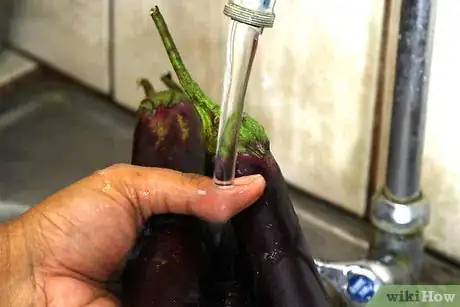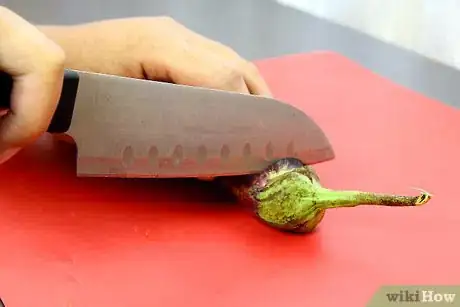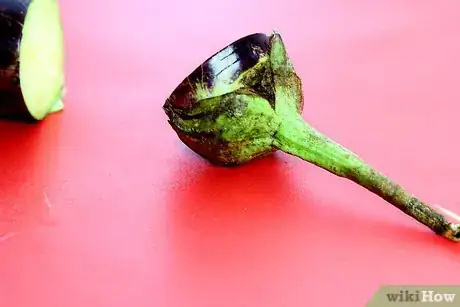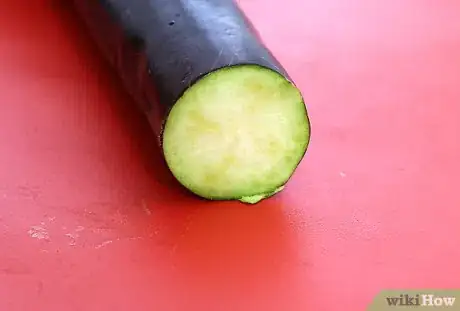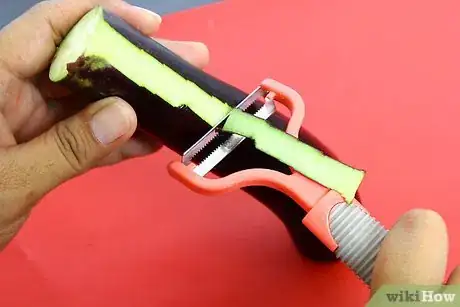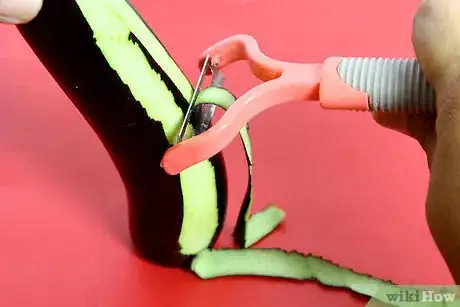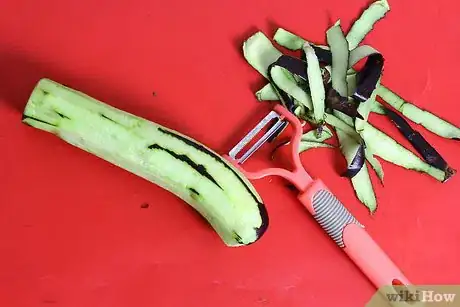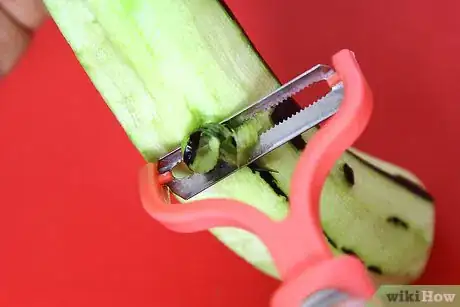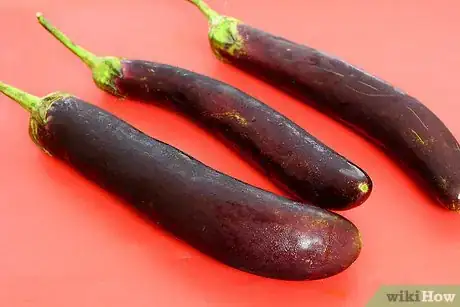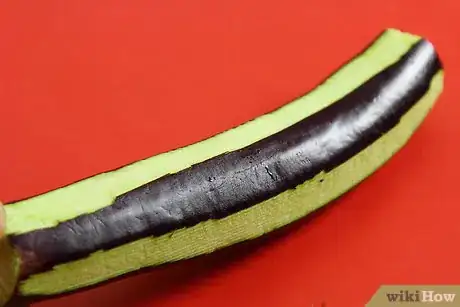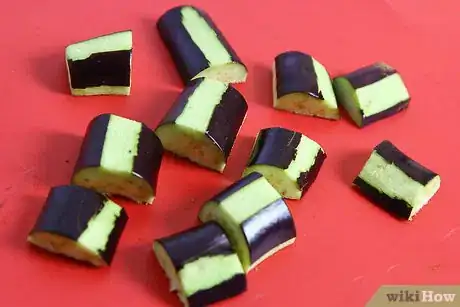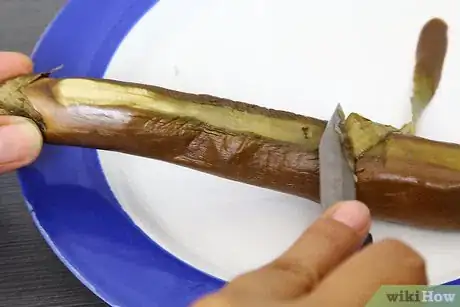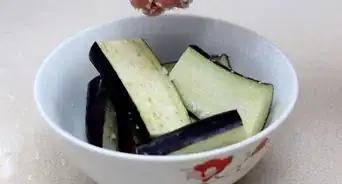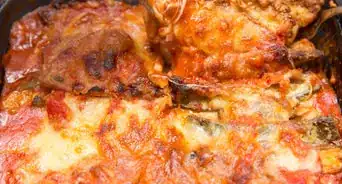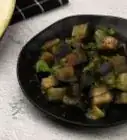wikiHow is a “wiki,” similar to Wikipedia, which means that many of our articles are co-written by multiple authors. To create this article, volunteer authors worked to edit and improve it over time.
There are 10 references cited in this article, which can be found at the bottom of the page.
This article has been viewed 136,477 times.
Learn more...
Peeling an eggplant often improves the taste and texture of an eggplant-based dish. Fortunately, the peeling process is both straightforward and simple.
Steps
Part One: Peel the Eggplant
-
1Wash the eggplant. Rinse the eggplant in cool running water, then dry it with clean paper towels.[1]
- Even though you'll be removing the skin, you should still take the time to clean the dirt from it. Bacteria and grime from the skin of the eggplant can get on your hands as you handle it during the peeling process. That debris can transfer from your hands to the flesh of the eggplant post-peeling. By cleaning the vegetable before you peel it, you minimize this risk.
- To the same end, you should also make sure that your hands are clean before you handle the eggplant. Wash your hands well with soap and water, then dry them off.[2]
-
2Cut off the end. Use a sharp kitchen knife to remove the stem end of the eggplant. Cut off the stem end in a clean slice, positioning the slice just below the base of the stem.[3]
- The part of the eggplant connected to the stem and the leaves is naturally tougher than the rest of the vegetable, so removing it will improve the eggplant's overall texture.
- Removing the stem also exposes the flesh of the eggplant, thereby giving you a cleaner, easier place to start your peeling.
- If desired, you can also cut off the bottom end of the eggplant during this time. The peel can be tricky to remove at the very bottom of the eggplant, so some people prefer to remove a 1/2 inch (1.25 cm) slice of eggplant from the bottom to avoid dealing with the skin there.
Advertisement -
3Peel off a strip of skin. Hold the eggplant in your non-dominant hand, bracing the bottom against your cutting board at a sideways tilt. Using your dominant had, position the blade of a vegetable peeler beside the skin on the top cut end of the eggplant. Draw the peeler down over the full length of the eggplant, taking a straight strip of skin with you as you go.[4]
- Always peel along the length of the eggplant (top to bottom) rather than peeling across the width (side to side). The eggplant is easier to handle when you peel along the length. As a result, the process will take much quicker and you are less likely to accidentally cut yourself.
- The bottom of the eggplant should be tilted away from you or to the side. Do not tilt it toward you, and do not draw the peeler toward you as you work.
- If you do not have a vegetable peeler, use a small paring knife, instead. Position the blade of the paring knife just beneath the skin at the top cut end of your eggplant. Draw the knife straight down the side of the vegetable, working carefully so that you only remove skin and do not remove any flesh from the eggplant.
-
4Remove the rest of the skin in the same manner. Place the blade of the vegetable peeler directly beside the bare strip on your eggplant. Draw it down the length of the vegetable again, removing another strip of skin and enlarging the bare spot on the eggplant. Continue working in this manner until the entire eggplant has been peeled.[5]
- Ideally, you should be able to remove the skin in clean strips, leaving none of it behind as you progress around the perimeter of the vegetable.
-
5Redo sections of stray skin. Look over the eggplant. If you notice any small strips or patches of skin that you missed the first time around, draw the blade of the vegetable peeler over those patches to remove them. Repeat this step as needed until the entire vegetable is bare.
- Continue to peel the skin away in lengthwise strips, rather than using crosswise strokes.
- This step completes the standard peeling process. You can use the eggplant as called for in your chosen recipe from this point on.
Part Two: Variations and Suggestions
-
1Consider leaving the skin on. Many people prefer the taste and texture of a peeled eggplant to that of an eggplant with its skin left intact, but the skin is edible, so you may not need to peel it off.[6]
- The peel provides dietary fiber, so it is nutritionally beneficial.[7]
- Unfortunately, the skin is also tough and bitter, making it somewhat unpleasant to eat.
- The necessity of peeling often depends on how the eggplant will be used. If you intend to roast or grill the vegetable in slices, leaving the skin on can help hold the flesh together. On the other hand, if you intend to cut the eggplant into cubes, quickly stir-fry slices of it, or bread it before cooking, the flesh should hold together even without the skin.
- As a general rule, always peel older eggplants that are nearly over-ripe. As an eggplant ages, the skin gets tougher and becomes more difficult to cook. Young, tender eggplants can be cooked with the skin on or off.[8]
-
2Peel the eggplant in a striped fashion. Doing this leaves some of the skin on the eggplant. The amount of skin that remains is enough to help hold the flesh of the eggplant together.[9]
- To peel the eggplant in stripes, follow the standard peeling procedure with one exception: instead of removing the skin in side-by-side strips, skip over a 1-inch (2.5-cm) section of skin before peeling off your next strip. The end result will be an eggplant with stripes of skin still intact at relatively even intervals around the perimeter of the vegetable.
-
3Peel only partially when cutting into slices. If you intend to cut the eggplant into lengthwise slices or planks, leaving most of the skin on is advisable. You should still peel off a section of skin on the front and back of the eggplant, however.
- Stand the eggplant upright on its end and remove a lengthwise strip of skin from one side. Remove another lengthwise strip of skin from the side directly opposite this first side, then cut the eggplant in lengthwise slices running parallel to these new bare spots. The sides of each slice should retain their peels, while the front and back of each slice should reveal the flesh of the eggplant.
- Doing this will allow the flesh to take on more color and flavor as you cook it.
-
4Remove the skin after you cook the eggplant. Even though the skin is usually removed before you cook the eggplant, you can separate the flesh of a cooked eggplant from its skin relatively easily before serving or consuming it.[10]
- You can use a paring knife to peel off the cooked skin. Wait for the eggplant to cool slightly so that you can handle it without burning your fingers. Use your non-dominant hand to hold the slice or section of eggplant in place, then use your dominant hand to carefully slice off the skin, removing as little flesh as possible in the process. The skin should separate from the flesh of the vegetable with relative ease at this point.
- Depending on how soft the eggplant is after you cook it, you may even be able to peel the skin off using your fingers.
- Alternatively, if you're the only one eating the eggplant and do not need to worry about serving a portion to someone else, you can separate the skin from the flesh by simply scooping the flesh out with a spoon or fork as you eat it, leaving the burnt, bitter peel on your plate.
Community Q&A
-
QuestionCan I leave the skin on the eggplant when you cook it?
 Community AnswerDefinitely, no matter which way you cook it, whether it is fried, baked or barbecued, the skin is delicious, nutritious and adds extra flavor.
Community AnswerDefinitely, no matter which way you cook it, whether it is fried, baked or barbecued, the skin is delicious, nutritious and adds extra flavor. -
QuestionIs the whole inside of an eggplant edible?
 Community AnswerYes. As it is related to the tomato, it can be eaten just like one: meat, seeds, and all.
Community AnswerYes. As it is related to the tomato, it can be eaten just like one: meat, seeds, and all. -
QuestionAfter I peel the eggplant, how do I cut it up?
 Community AnswerThere are many different ways of cutting an eggplant. The most popular options I have seen are to either cut it into slices, like tomatoes for a burger, or dice it like you would an onion. Both have their appeals; a large slice lets you have a pretty plate, whereas dicing it lets you eat it without needing a knife.
Community AnswerThere are many different ways of cutting an eggplant. The most popular options I have seen are to either cut it into slices, like tomatoes for a burger, or dice it like you would an onion. Both have their appeals; a large slice lets you have a pretty plate, whereas dicing it lets you eat it without needing a knife.
Things You'll Need
- Paper towels
- Kitchen knife
- Vegetable peeler or paring knife
References
- ↑ https://extension.umaine.edu/publications/4336e/
- ↑ https://www.cdc.gov/handwashing/when-how-handwashing.html
- ↑ https://www.bhg.com/recipes/how-to/cooking-basics/how-to-cook-eggplant/
- ↑ https://www.youtube.com/watch?v=sYLaKSrEk70
- ↑ https://www.recipetips.com/kitchen-tips/t--1408/how-to-cut-an-eggplant.asp
- ↑ https://www.youtube.com/watch?v=UxGllGx7vGg
- ↑ https://www.webmd.com/food-recipes/eggplant-health-benefits
- ↑ http://urbanext.illinois.edu/veggies/eggplant.cfm
- ↑ http://www.finecooking.com/articles/how-to/cook-eggplant-to-perfection.aspx
About This Article
To peel an eggplant, first rinse the eggplant under cool, running water and pat it dry with clean paper towels. Cut the stem and bottom ends off of the eggplant with a sharp kitchen knife. Hold the eggplant in your non-dominant hand with the bottom end braced against a flat surface, like a cutting board. With your dominant hand, position a vegetable peeler at the top edge of the eggplant and pull it downward along the length of the eggplant to remove a strip of skin. Keep removing strips of peel until the eggplant is completely skinless. You may need to touch up any spots that you missed. If you don’t have a vegetable peeler, you can also use a sharp paring knife. Work carefully to avoid cutting yourself or accidentally stripping away the flesh of the eggplant as well as the peel. Keep reading to learn how to remove the skin after you cook the eggplant!
